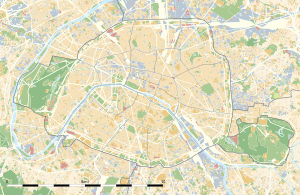Pont de la Concorde (Paris)
Coordinates: 48 ° 51 ′ 48 ″ N , 2 ° 19 ′ 11 ″ E
| Pont de la Concorde | ||
|---|---|---|
| use | Road bridge | |
| Crossing of | His | |
| place | Paris | |
| construction | Stone u. Concrete arch | |
| overall length | 153 m | |
| width | 35 m | |
| Number of openings | 5 | |
| Longest span | 31 m | |
| start of building | 1771 | |
| completion | 1791/1932 | |
| planner | Jean-Rodolphe Perronet | |
| location | ||
|
|
||
The Pont de la Concorde is a bridge over the Seine in Paris , France . It connects the Place de la Concorde and the Quai des Tuileries with the Quai d'Orsay and runs exactly towards the Palais Bourbon , the seat of the Assemblée Nationale , the French national assembly.
During the planning phase it was called Pont Louis XV , then successively Pont Louis XVI , Pont de la Révolution , Pont de la Concorde , during the restoration again Pont Louis XVI and finally, from 1830, again Pont de la Concorde .
The Pont de la Concorde is one of the busiest bridges in Paris, apart from the bridges on the Boulevard périphérique .
description
The 153 m long bridge consists of five segment arches with spans of 25 m, 28 m, 31 m, 28 m and 25 m. The stone arch bridge planned by Jean-Rodolphe Perronet and built under his direction was originally 15 m wide. In the years 1931–1932, Henri Lang extended it to 35 m by adding a row of reinforced concrete arches with exactly the same profile on each side, which were given an external cladding in the old style. The extension can still be seen if one looks diagonally through an arch and the opening there between the pillars of the old and the new arch just above the surface of the water. The largest arch is 1.30 m thick at the top. The bridge deck, which is arched very flat over its entire length, is divided into three lanes in both directions, a cycle path and two very wide walkways, which are bordered by stone balustrades . The almost three meter thick pillars are founded on piles, the extensions on caissons .
history
A wooden bridge was to be built as early as 1725, as the numerous new houses in the suburbs of Saint-Germain and Saint-Honoré also required a new connection across the Seine. However, this decision had no consequences. It was not until September 1786 that the construction of the bridge was decided by an edict of the king, whereupon the parliament approved a budget for the following year on September 7, 1786. On October 1, 1786, Perronet presented the motto , the specifications for the bridge. The tender on the basis of this motto took place in January 1787 and the award of the work on February 27, 1787. At this time contracts for the delivery of wood for the falsework had already been concluded, which the construction company had to take over. While the motto was still to procure the hewn stones for the bridge from quarries in Saillancourt near Meulan, at least a larger part should actually come from the Bastille , which was stormed on July 14, 1789 and then demolished . Perronet managed to build the bridge in the last years of the Ancien Régime , which was marked by financial difficulties, and during the beginning of the French Revolution , and to have it completed in 1791.
In 1810 Napoleon Bonaparte had statues of eight generals killed in the battles of the Premier Empire erected on the bridge. During the restoration , they were replaced by twelve monumental statues, each of which represented four ministers ( Suger , Sully , Richelieu , Colbert ), generals ( Du Guesclin , Bayard , Condé , Turenne ) and naval officers ( Duquesne , Tourville , Duguay-Trouin , Suffren ) . Since its total weight was too high for the bridge, Louis-Philippe I had it moved to Versailles Palace .
1931–1932 the bridge was expanded; In 1983 it was renovated.
The Pont de la Concorde has been protected as a Monument historique since July 12, 1975 .
Publications
- Jean-Rodolphe Perronet: Pont projetté pour être construit sur la Seine au droit de la Place Louis XV in: Description des projets et de la construction des ponts de Neuilli, de Mante, d'Orléans, de Louis XVI, etc. On ya ajouté the project of the canal de Bourgogne, for the communication of deux mers par Dijon; et de celui de la conduite des eaux de l'Yvette et de la Bievre à Paris . P. 264 ff. Didot fils aîné = Jombert jeune, Paris, 1788. Digitized on Google Books, accessed on February 29, 2012.
- JFW Dietlein: Perronets works, the description of the designs and the construction types of the bridges at Neuilli, Mantes, Orleans, Louis XVI. etc. containing the draft of the Burgundian Canal and that of the aqueduct from the Yvette and Bievre to Paris, as well as several individual treatises. Translated from the French by JFW Dietlein. Halle, from Hemmerde und Schwetschke, 1820. Digitized on Google Books, accessed on February 29, 2012.
- Perronet: motto des ouvrages à faire pour la construction du pont de Louis XVI . Imprimerie de Lottin l'aîné & Lottin, Paris, 1787. Digitized from Google Books, accessed February 29, 2012.
Web links
- Pont de la Concorde (1791). In: Structurae
- Pont de la Concorde (1932). In: Structurae
- LCPC - Bridges of Paris , accessed March 5, 2012
- Pont de la Concorde on Planète TP, accessed March 5, 2012
- Pont de la Concorde on Base Mérimée , accessed March 5, 2012

